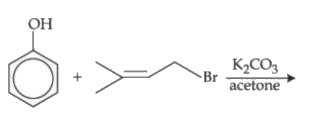Assertion: Benzyl bromide when kept in acetone water produces benzyl alcohol.
Reason: The reaction follows SN2 mechanism.
If both assertion and reason are true and the reason is the correct explanation of the assertion.
If both assertion and reason are true but reason is not the correct explanation of the assertion.
If assertion is true but reason is false.
If the assertion and reason both are false.
The correct Answer is:A
The assertion that on keeping benzyl bromide in acetone water it produces benzyl alcohol is correct. Because C6H5CH2Br hydrolysed to produce C6H5CH2OH . This conversion is of SN2 mechanism
Topper's Solved these Questions
- GENERAL ORGANIC CHEMISTRY BOOK - ERRORLESSCHAPTER - GENERAL ORGANIC CHEMISTRY EXERCISE - PAST YEARS QUESTIONS
85 Videos
- ENVIRONMENTAL CHEMISTRYBOOK - ERRORLESSCHAPTER - ENVIRONMENTAL CHEMISTRYEXERCISE - ASSERTION & REASON
7 Videos
- HYDROCARBONSBOOK - ERRORLESSCHAPTER - HYDROCARBONSEXERCISE - ASSERTION & REASON
18 Videos
Similar Questions
Knowledge Check
Assertion: Benzyl bromide when kept in acetone-water, it produces benzyl alcohol.
Reason The reaction follows SN2 mechanism.AAssertion and reason both are correct statements and reason is correct explanation for assertion.BAssertion and reason both are correct statements but reason is not correct explanation for assertionCAssertion is correct statement but reason is wrong statement.DAssertion is wrong statement but reason is correct statement.Assertion: Benzyl bromide when kept in acetone water produces benzyl alcohol.
Reason: The reaction follows SN2 mechanism.AIf both assertion and reason are true and the reason is the correct explanation of the assertionBIf both assertion and reason are true and the reason is not the correct explanation of the assertion.CIf assertion is true but reason is false.DIf the assertion and reason both are false.(A) Benzyl bromide when kept in acetone water it produces benzyl alcohol.
(R) The reaction follows SN2 mechanism.AIf both (A) and (R) are correct and (R) is the correct explanation of (A)BIf both (A) and (R) are correct but (R) is not the correct explanation of (A)CIf (A) is correct but (R) is incorrect.DIf (A) is incorrect but (R) is correct.
Which of the following reaction follows SN1 mechanism ?
View SolutionWhich of the following reaction follows SN1 mechanism ?
View SolutionAssertion : Tert- butyl methyl ether on cleavage with HI at 373 K gives tert-bytyl iodide and methano.
Reason : The reaction occurs by SN1 mechanism.
View SolutionAssertion: RI is more reactive than RCI towarde SN reaction
Reason: The rate of reaction for SN1 or SN2 mechanism is RI>RCI .
View SolutionAssertion: Methoxy ethane reacts with HI to give ethanol and iodomethane
Reason: Reaction of ether with HI follows S2N mechanism
View Solution

